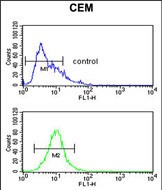FUT1 Antibody (Center)
Purified Rabbit Polyclonal Antibody (Pab)
- SPECIFICATION
- CITATIONS
- PROTOCOLS
- BACKGROUND

Application
| FC, WB, E |
|---|---|
| Primary Accession | P19526 |
| Other Accession | Q10979 |
| Reactivity | Human |
| Predicted | Rabbit |
| Host | Rabbit |
| Clonality | Polyclonal |
| Isotype | Rabbit IgG |
| Calculated MW | 41251 Da |
| Antigen Region | 164-195 aa |
| Gene ID | 2523 |
|---|---|
| Other Names | Galactoside 2-alpha-L-fucosyltransferase 1, Alpha(1, 2)FT 1, Blood group H alpha 2-fucosyltransferase, Fucosyltransferase 1, GDP-L-fucose:beta-D-galactoside 2-alpha-L-fucosyltransferase 1, FUT1, H, HSC |
| Target/Specificity | This FUT1 antibody is generated from rabbits immunized with a KLH conjugated synthetic peptide between 164-195 amino acids from the Central region of human FUT1. |
| Dilution | FC~~1:10~50 WB~~1:1000 E~~Use at an assay dependent concentration. |
| Format | Purified polyclonal antibody supplied in PBS with 0.09% (W/V) sodium azide. This antibody is prepared by Saturated Ammonium Sulfate (SAS) precipitation followed by dialysis against PBS. |
| Storage | Maintain refrigerated at 2-8°C for up to 2 weeks. For long term storage store at -20°C in small aliquots to prevent freeze-thaw cycles. |
| Precautions | FUT1 Antibody (Center) is for research use only and not for use in diagnostic or therapeutic procedures. |
| Name | FUT1 (HGNC:4012) |
|---|---|
| Synonyms | H, HSC |
| Function | Catalyzes the transfer of L-fucose, from a guanosine diphosphate-beta-L-fucose, to the terminal galactose residue of glycoconjugates through an alpha(1,2) linkage leading to H antigen synthesis that is an intermediate substrate in the synthesis of ABO blood group antigens (PubMed:2118655). H antigen is essential for maturation of the glomerular layer of the main olfactory bulb, in cell migration and early cell-cell contacts during tumor associated angiogenesis (PubMed:18205178). Preferentially fucosylates soluble lactose and to a lesser extent fucosylates glycolipids gangliosides GA1 and GM1a (By similarity). |
| Cellular Location | Golgi apparatus, Golgi stack membrane {ECO:0000250|UniProtKB:O09160}; Single-pass type II membrane protein {ECO:0000250|UniProtKB:O09160}. Note=Membrane-bound form in trans cisternae of Golgi. {ECO:0000250|UniProtKB:O09160} |

Thousands of laboratories across the world have published research that depended on the performance of antibodies from Abcepta to advance their research. Check out links to articles that cite our products in major peer-reviewed journals, organized by research category.
info@abcepta.com, and receive a free "I Love Antibodies" mug.
Provided below are standard protocols that you may find useful for product applications.
Background
FUT1 is a Golgi stack membrane protein that is involved in the creation of a precursor of the H antigen, which is required for the final step in the soluble A and B antigen synthesis pathway.
References
Moehler,T.M., J. Cell. Physiol. 215 (1), 27-36 (2008)
Moore,G.T., Mol. Immunol. 45 (8), 2401-2410 (2008)
If you have used an Abcepta product and would like to share how it has performed, please click on the "Submit Review" button and provide the requested information. Our staff will examine and post your review and contact you if needed.
If you have any additional inquiries please email technical services at tech@abcepta.com.













 Foundational characteristics of cancer include proliferation, angiogenesis, migration, evasion of apoptosis, and cellular immortality. Find key markers for these cellular processes and antibodies to detect them.
Foundational characteristics of cancer include proliferation, angiogenesis, migration, evasion of apoptosis, and cellular immortality. Find key markers for these cellular processes and antibodies to detect them. The SUMOplot™ Analysis Program predicts and scores sumoylation sites in your protein. SUMOylation is a post-translational modification involved in various cellular processes, such as nuclear-cytosolic transport, transcriptional regulation, apoptosis, protein stability, response to stress, and progression through the cell cycle.
The SUMOplot™ Analysis Program predicts and scores sumoylation sites in your protein. SUMOylation is a post-translational modification involved in various cellular processes, such as nuclear-cytosolic transport, transcriptional regulation, apoptosis, protein stability, response to stress, and progression through the cell cycle. The Autophagy Receptor Motif Plotter predicts and scores autophagy receptor binding sites in your protein. Identifying proteins connected to this pathway is critical to understanding the role of autophagy in physiological as well as pathological processes such as development, differentiation, neurodegenerative diseases, stress, infection, and cancer.
The Autophagy Receptor Motif Plotter predicts and scores autophagy receptor binding sites in your protein. Identifying proteins connected to this pathway is critical to understanding the role of autophagy in physiological as well as pathological processes such as development, differentiation, neurodegenerative diseases, stress, infection, and cancer.



